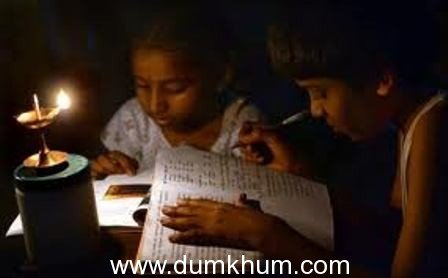One Child One Light : a project to brighten up schooling days
Manish Desai / Bhavana Gokhale
Introduction – Changed rural scenario
Over the last two decades, the rural areas of India have witnessed many changes. There are better road connections, there is a significant improvement in health care, literacy levels have gone up and mobile phones have become ubiquitous. But one thing that hasn’t changed much is the sorry state of electricity supply. 12-14 hours load shedding is a common phenomenon across most states of the country. When there is no electricity for such a long time span, one of the most affected lot are the school going children.
In absence of electricity, students either do not study at all or they study under kerosene lamp. Either situation is not good. In India over 120 million children depend upon crude kerosene lamp for studying due to lack of grid electricity supply. Kerosene lamps do not emit sufficient light to enable children to read in comfort. They also emit carbon monoxide, which is harmful to the health of a child. There is also a chance of kerosene spilling resulting in a fire hazard. The end result -students fail to keep pace with school teaching and when they pass, they are less confident and less skillful to find employment opportunities.
Therefore the availability of light during the study hours of children is very important. So how to address this challenge?
LED Study Lights – The Best Solution
Among all possible solutions, solar energy based solar lanterns appear to provide the cheapest and quickest solution.
Emerging LED lighting technology which is semiconductor based presents a wonderful solution to this simple lighting issue. With the white LED revolution it is now possible to provide a simple light suitable for reading purpose that consumes less than a quarter watt but provides 10 to 50 times more useable light than a wick lamp.
Hyderabad based Voluntary Organization Thrive Energy Technologies has indigenously developed a Solar Study light which provides enough light intensity for study purpose. It gives 7-8 hours of light per day on full charge.
Features of Solar LED
Provides close to 150 lux of evenly distributed light output as compared to 2-3 lux of light output provided by a flickering wick lamp
Uses a NiMH (Nickel-metal Hydride) battery, which can be charged either by using the 0.5 watt solar panel provided or by an AC mobile charger or by a solar powered bulk charging system, Uses the world’s best LED and an advanced IC that ensures consistent and quality lighting even after many years of use.
“The lights are designed to be very rugged and fail proof considering the rural environment. Through innovation in technology and processes, these lights are up to 40% less expensive than commercially available lights of similar quality” says Ravi Tejwani of IIT-Bombay, closely associated with the project.
Khargone Experiment : One Child One Light
‘One Child One Light” is a project initiated for providing solar light to 100 students each from 100 schools, totaling to 10,000 lights in Khargone district located in South West Madhya Pradesh. It is proposed to target 100 schools from Zhirnya and Bhagwanpura Tehsil, which are among the most backward during the pilot stage. The main plan is to distribute as many as 100,000 lights in the district.
Khargone district of MP has been chosen as pilot as more than 84% population lives in rural area of which 40% belongs to SC/ST category. Over 40% people use kerosene for lighting purpose. Per capita electricity consumption in MP is only about 330 units per year, while the same is 750 units for India and on an average 2000 units for the world.
The project is being executed by Education Park located in Khargone district in collaboration with Thrive Energy Technologies, Hyderabad. So far, more than 4500 solar LED lights have been distributed. The objective is to distribute
How the project works
The subsidized cost of the solar light is only Rs 200 for students, although the MRP is Rs 580/
-. “These Solar lights will be centrally charged at school while the child is studying through common solar PV modules installed on the terrace of the school. Lamps are kept on a charging rack during the day time, and 4 to 5 hours of charge would be good enough for the lamp to provide 2 -3 hours of light during the night for 2 -3 three days” says Tejwani. Student, who owns solar lamp, takes it home for study during night. The student brings the light back to the school for recharging whenever it is due.
Benefits of the project
The project, once implemented successfully, will bring lot of benefits directly and indirectly in the society.
• 10,000 students getting solar lights will result in 30 lakh extra study hours per year.
• It will bring awareness among parents, teachers and administrators and encourage people to get their own solar lights. Another domestic light model is also available for home use.
• It will help reduce demand for kerosene, which is already in short supply, which in turn will save precious foreign exchange for the country.
• It will reduce the health hazard to children caused by the use of kerosene lamps.
• The implementation of this project will result in saving of 1.5 million tons of Carbon Dioxide emission per year.
The purpose of this project is to demonstrate the effect and impact of the project on the social life of Madhya Pradesh and encourage governments to adopt solar lamps for lighting purpose as the most cost effective solution in rural areas.
India’s focus on solar energy
Government of India has recognized the importance of solar energy and has launched the Jawaharlal Nehru National Solar Mission. The immediate aim of the Mission is to focus on setting up an enabling environment for solar technology penetration in the country both at a centralized and decentralized level. To promote research the National Centre for Photovoltaic Research and Education (NCPRE) has been set up at IIT Bombay, to carry out basic and applied research activities. Eventually, NCPRE aims to make solar PV a cost-effective and relevant technology option.









